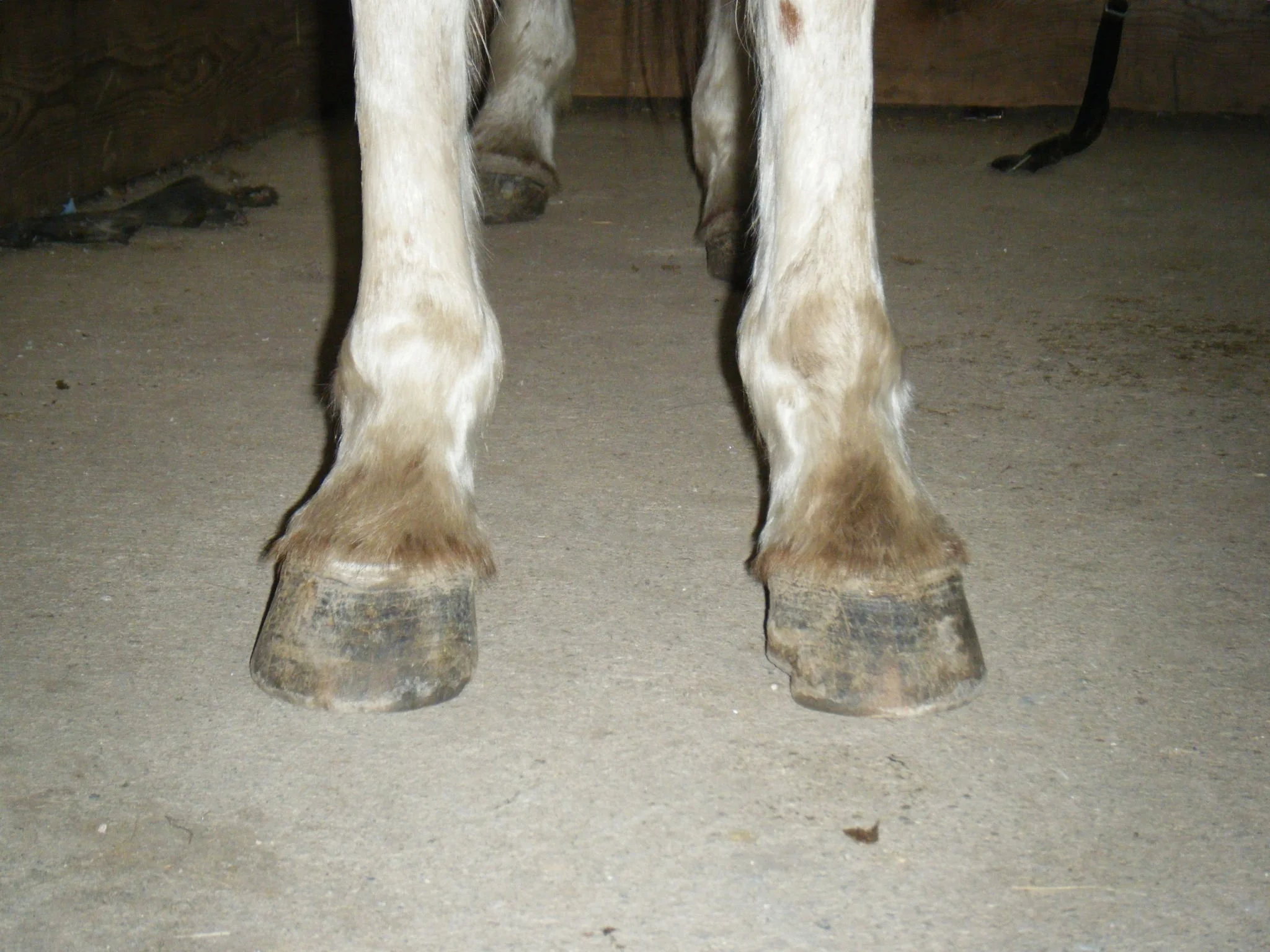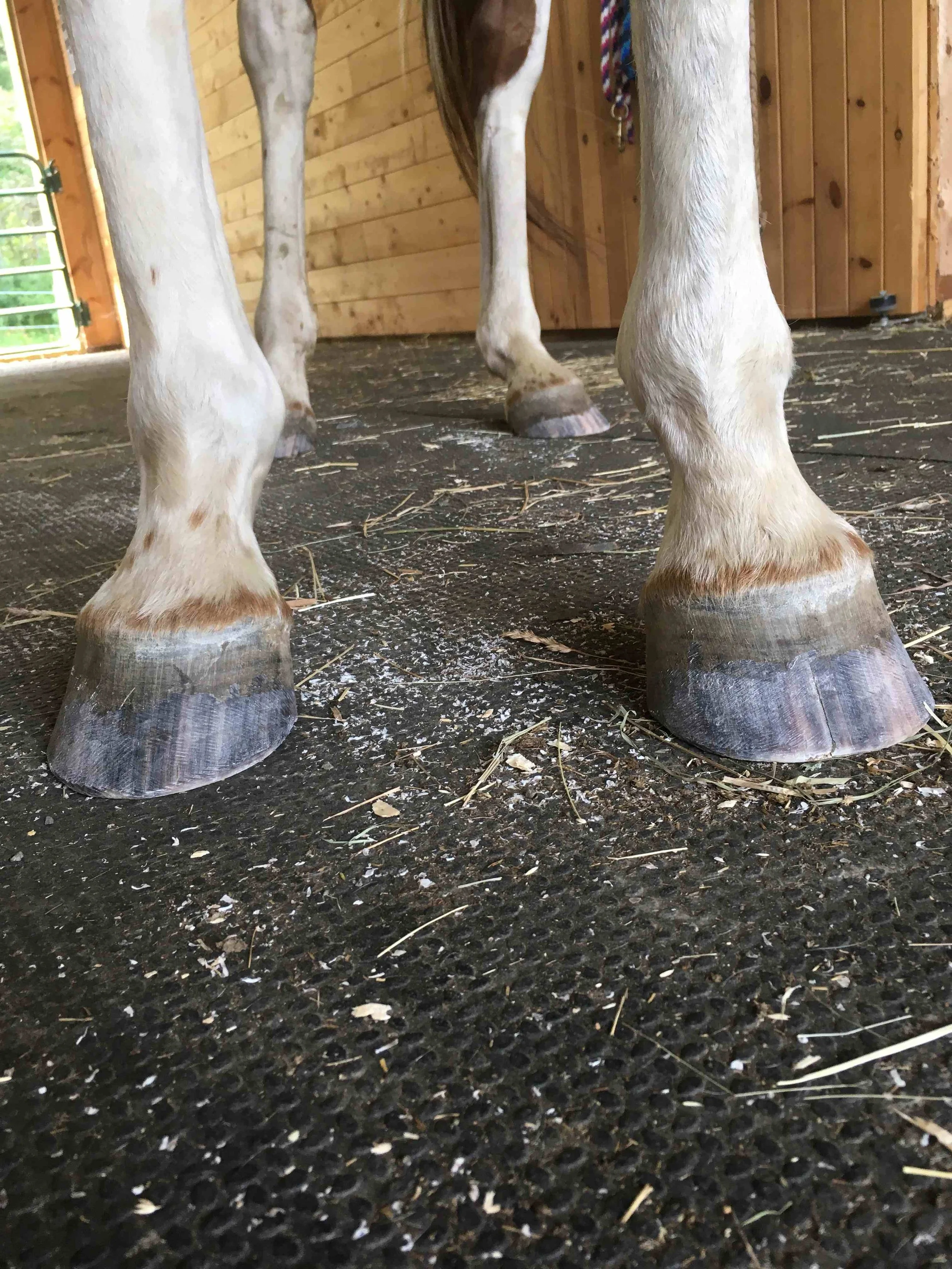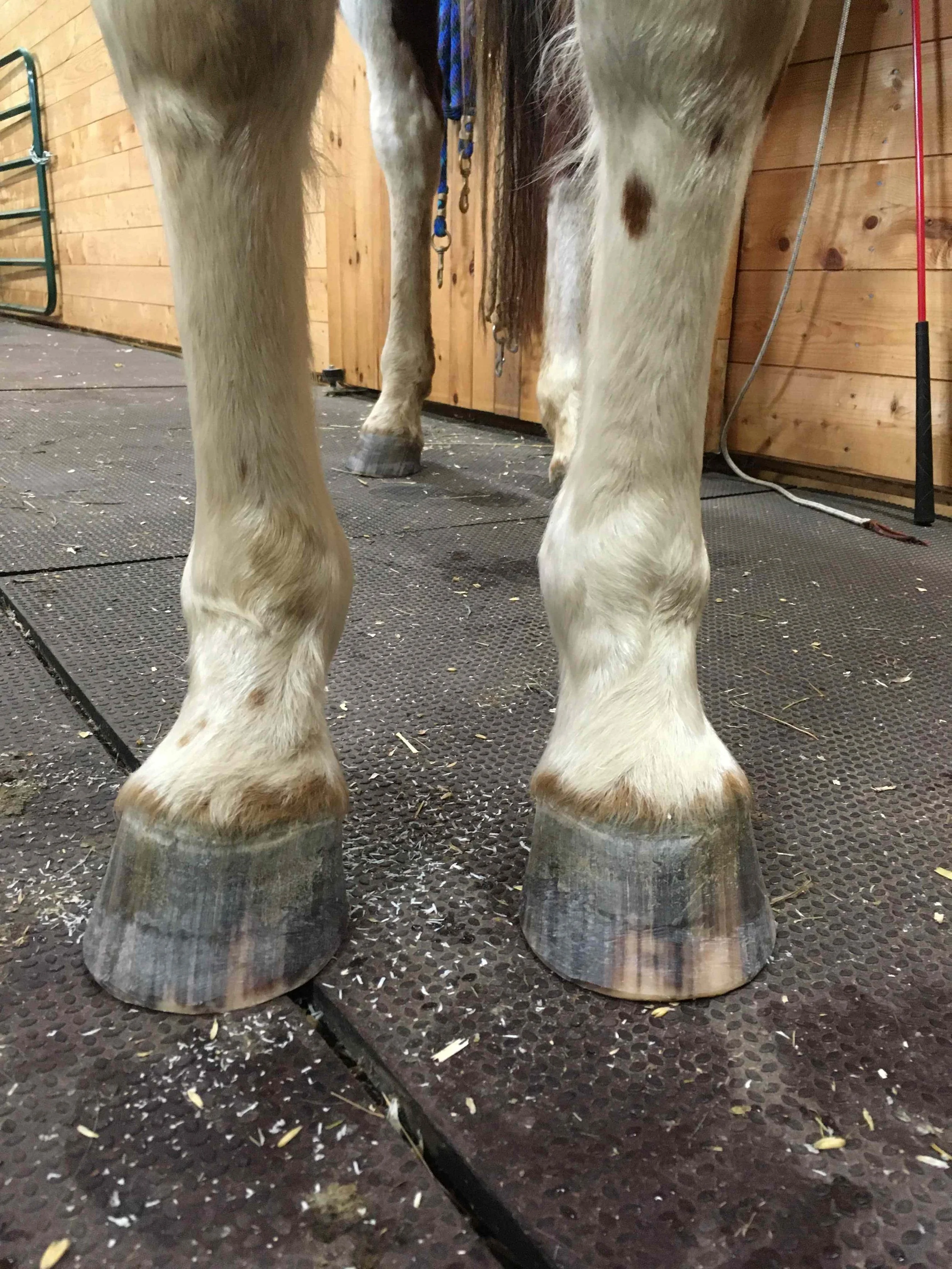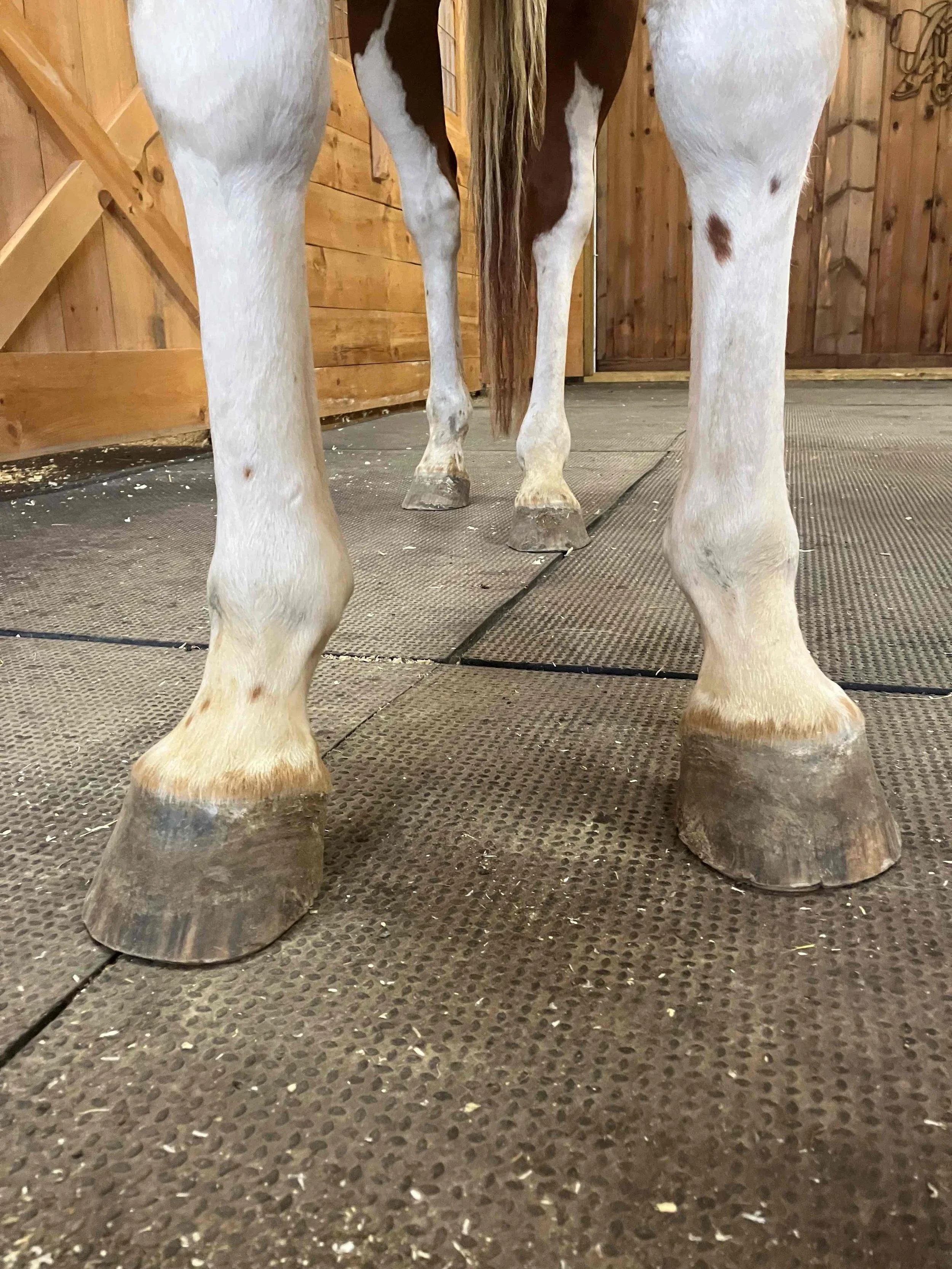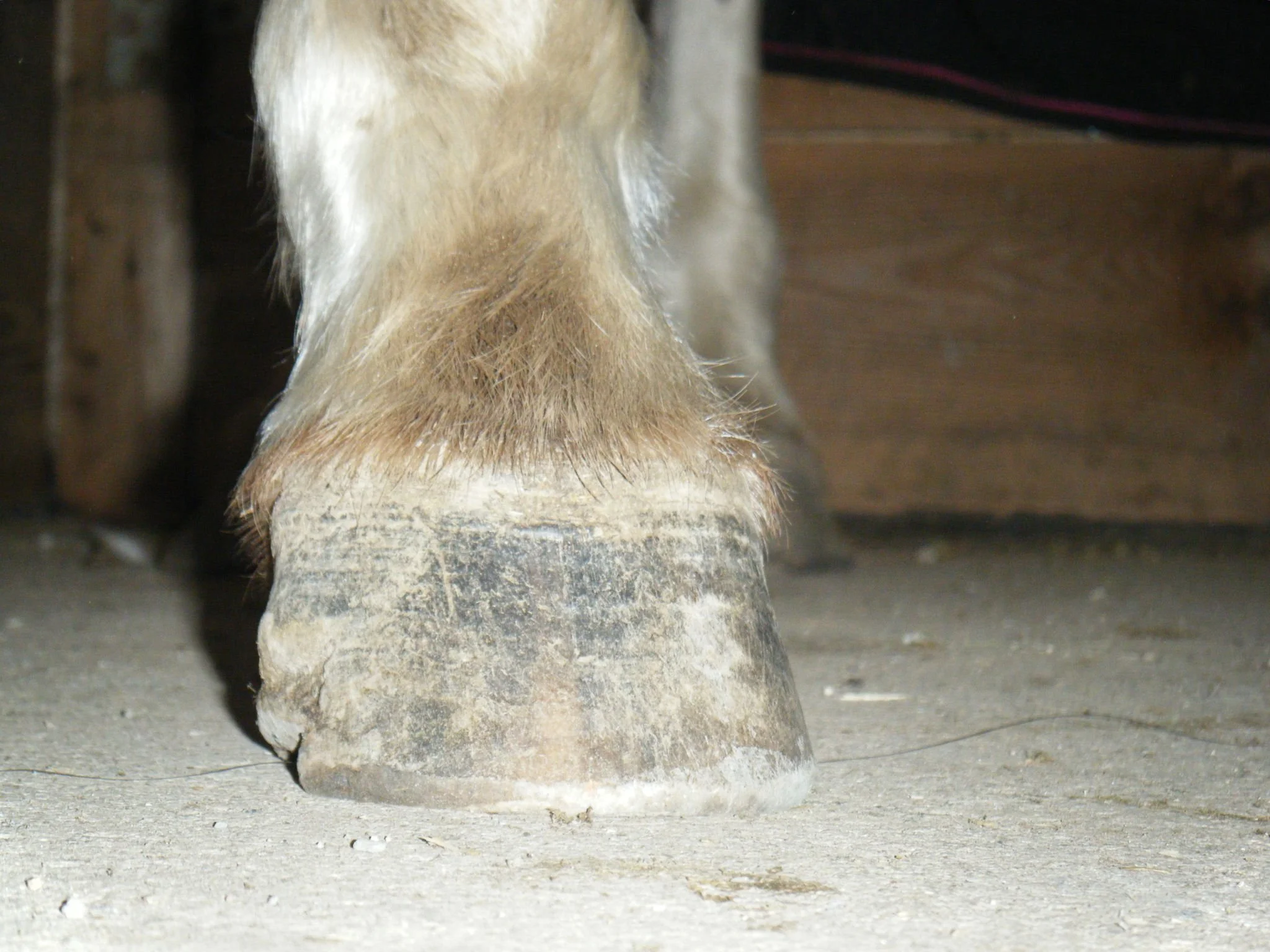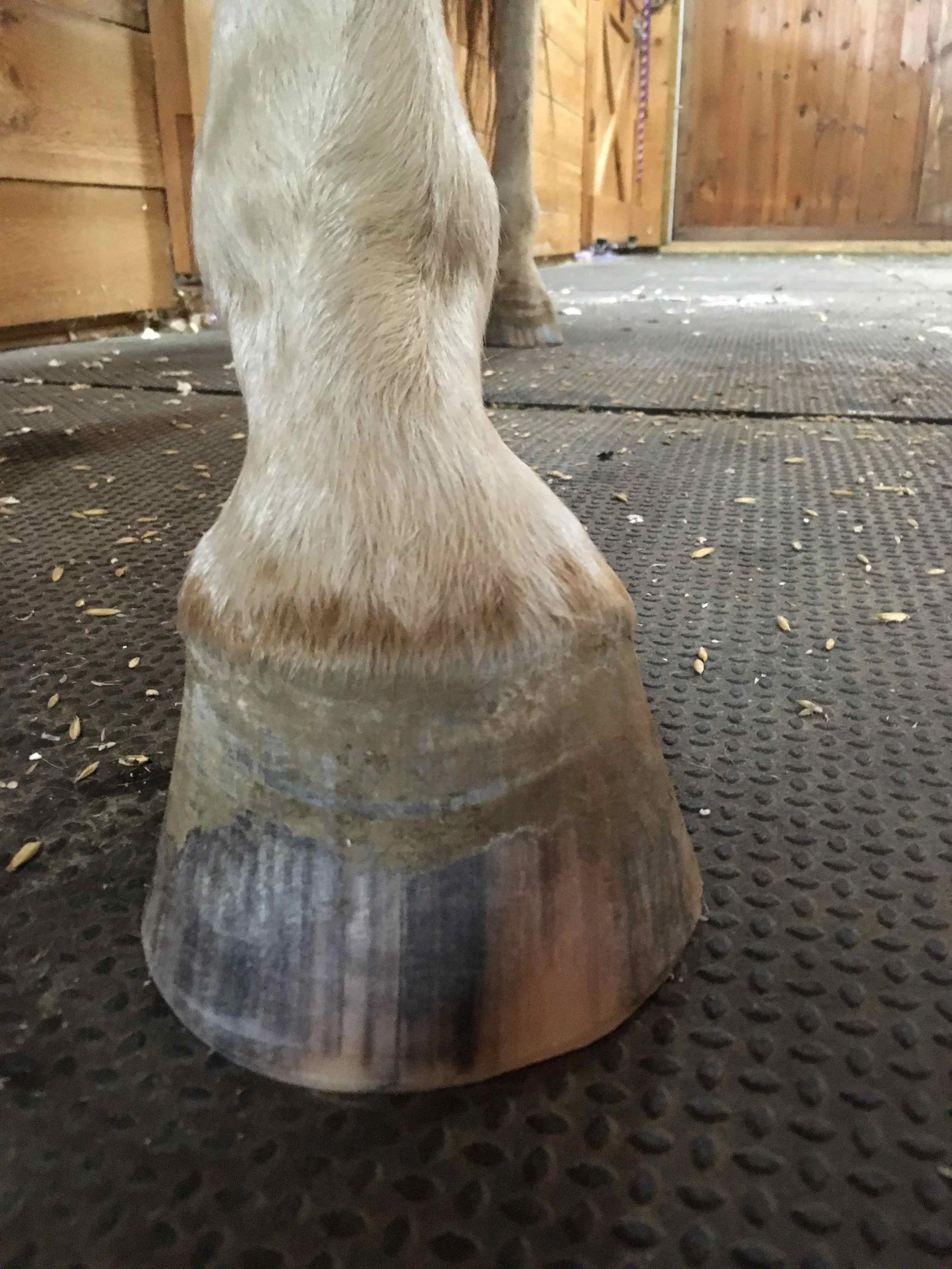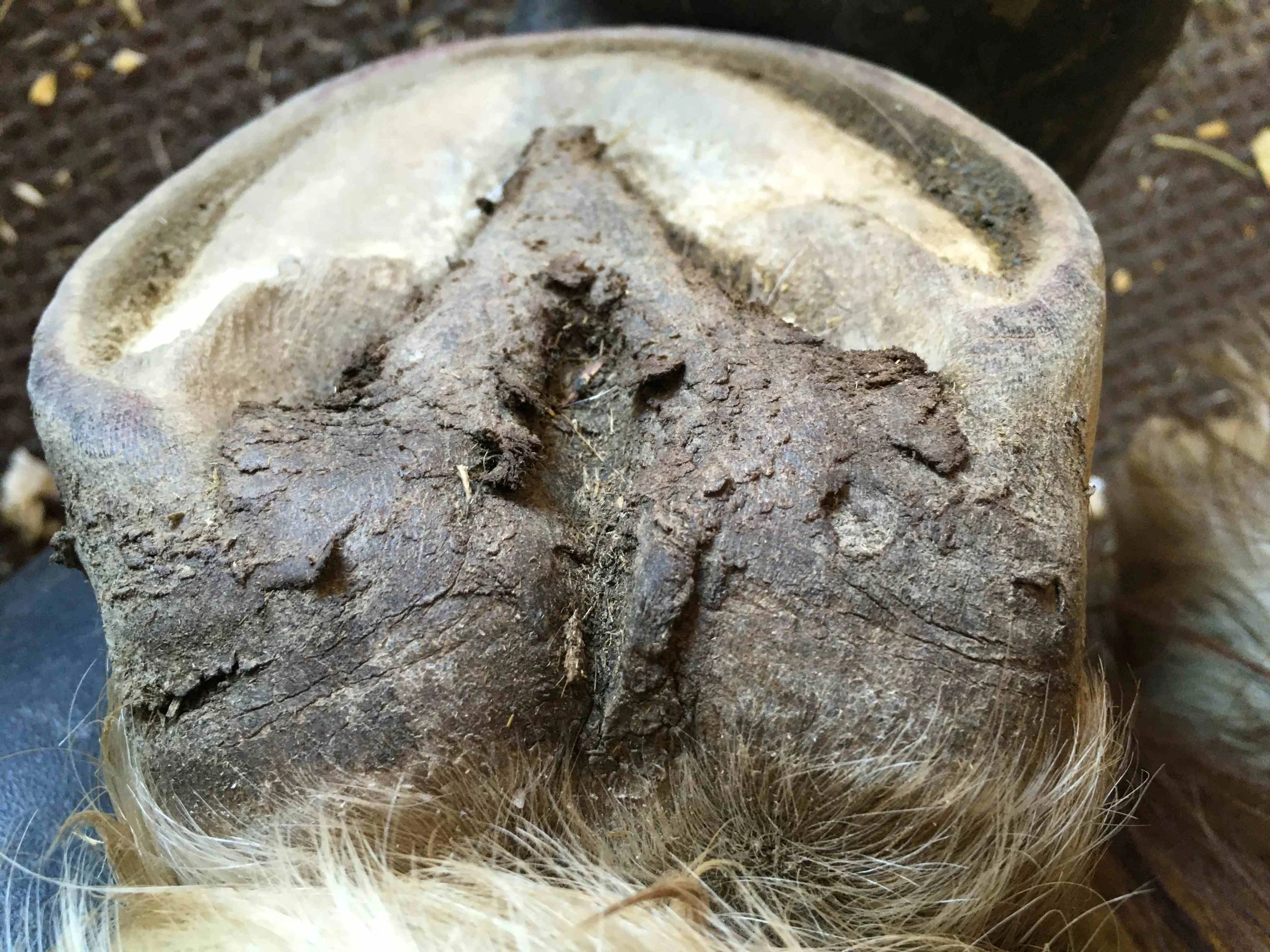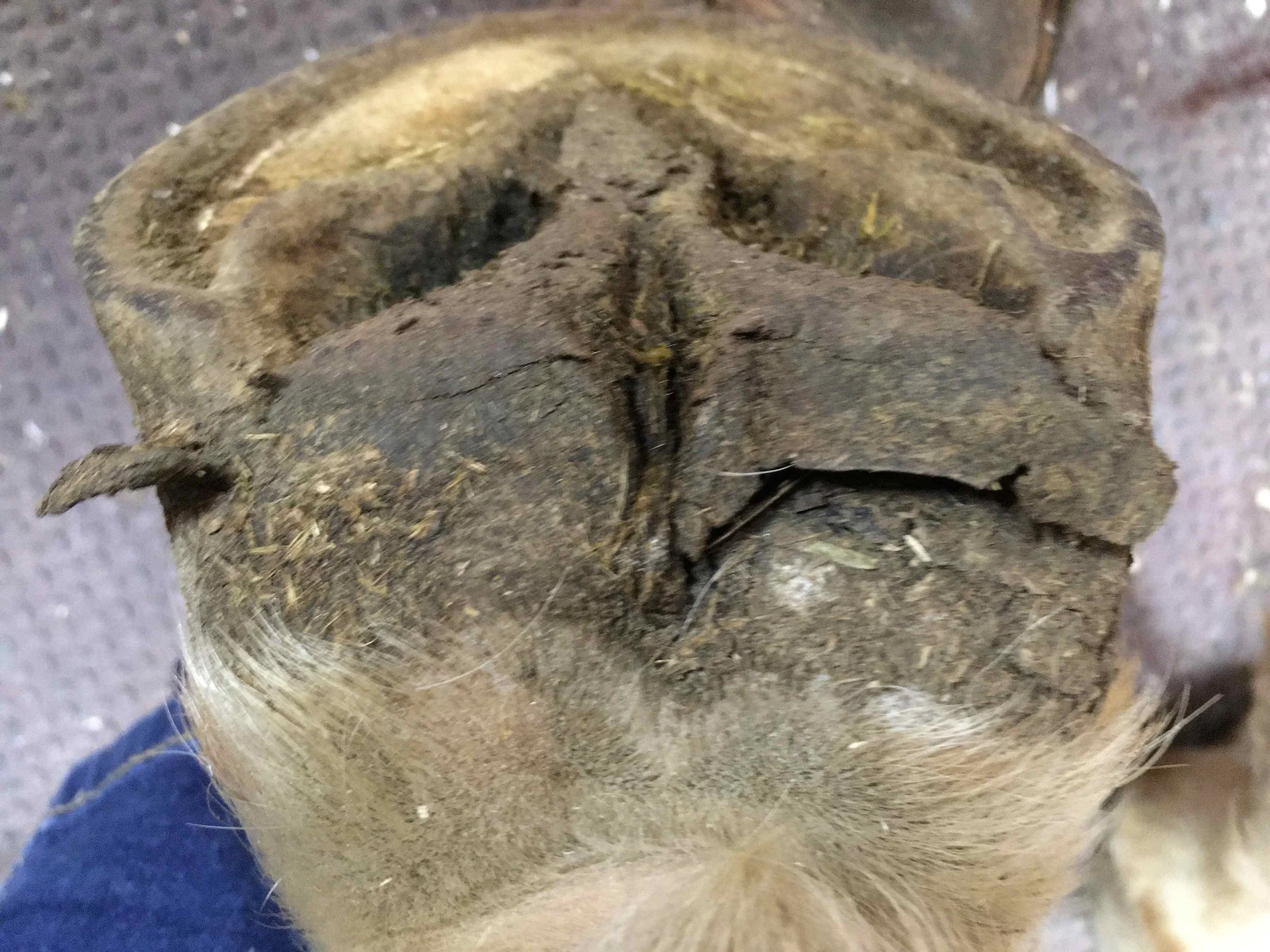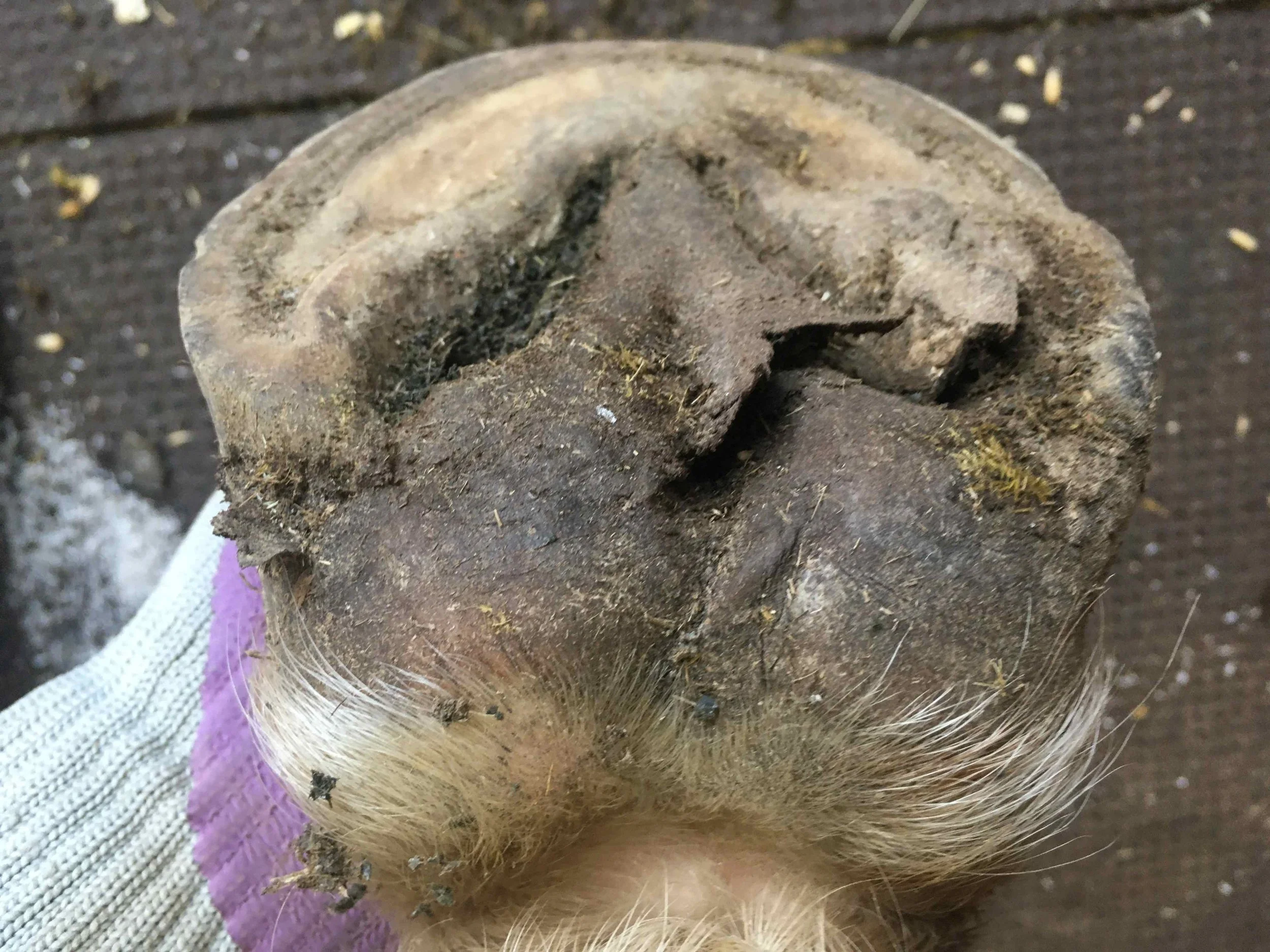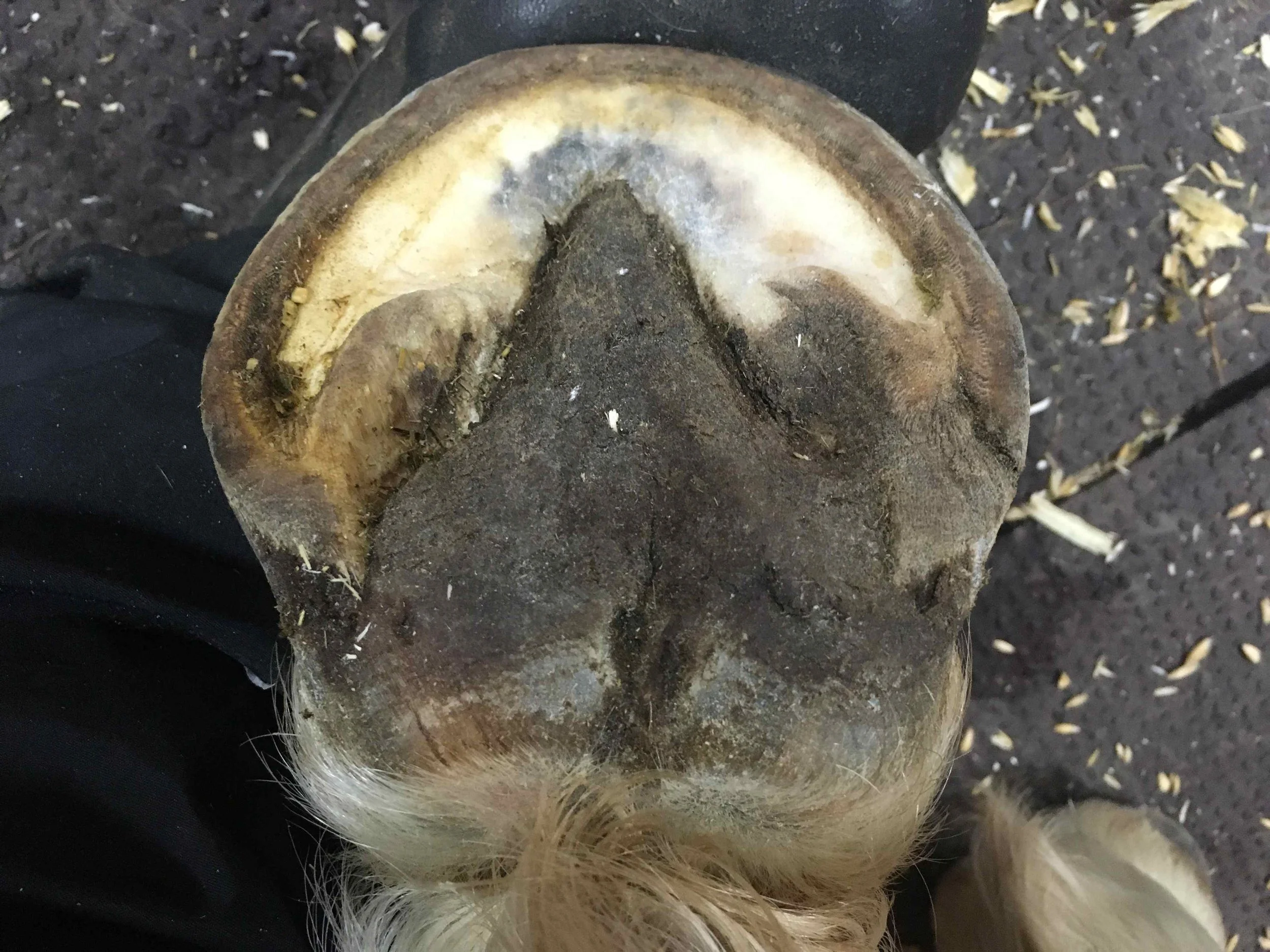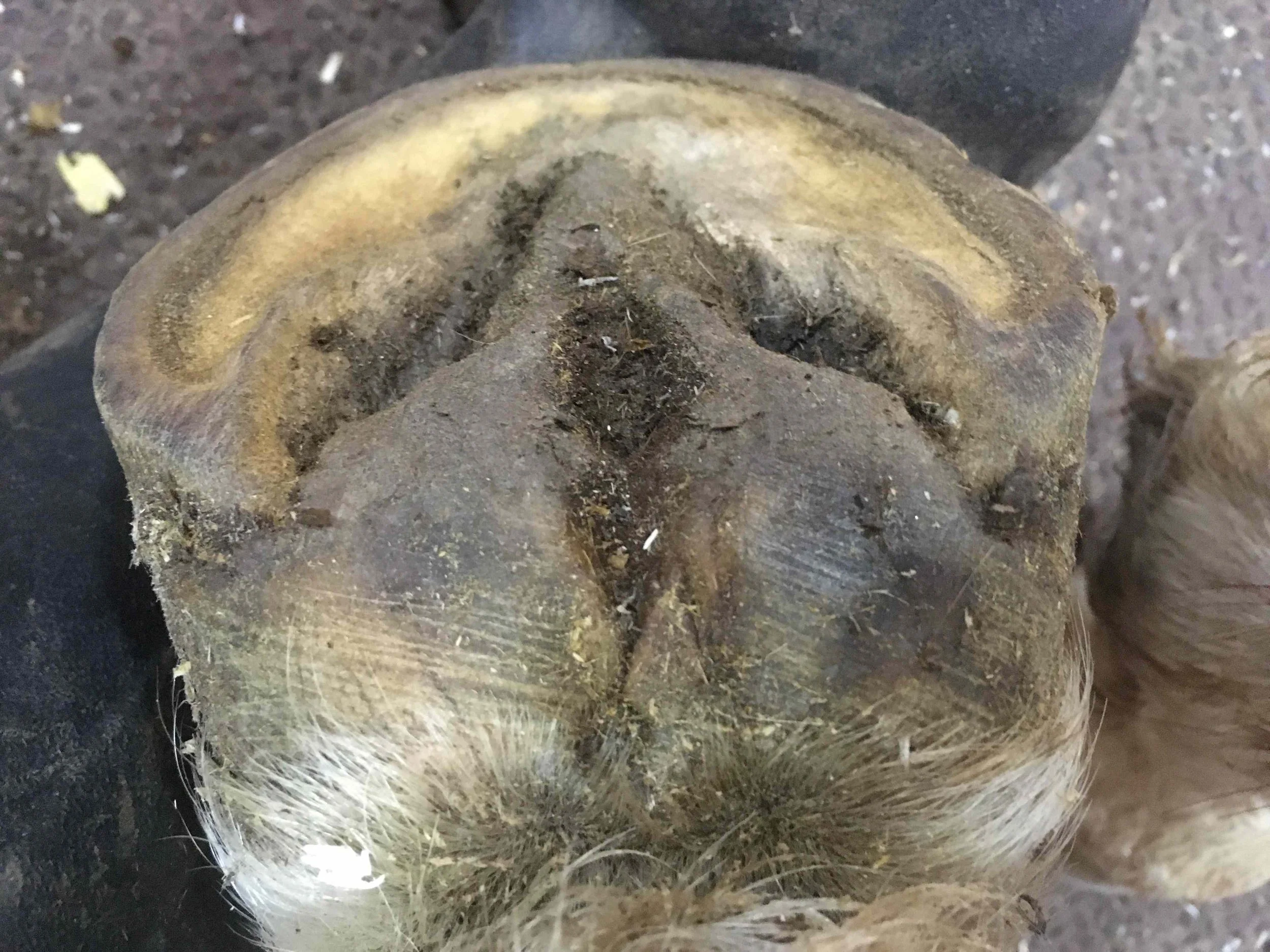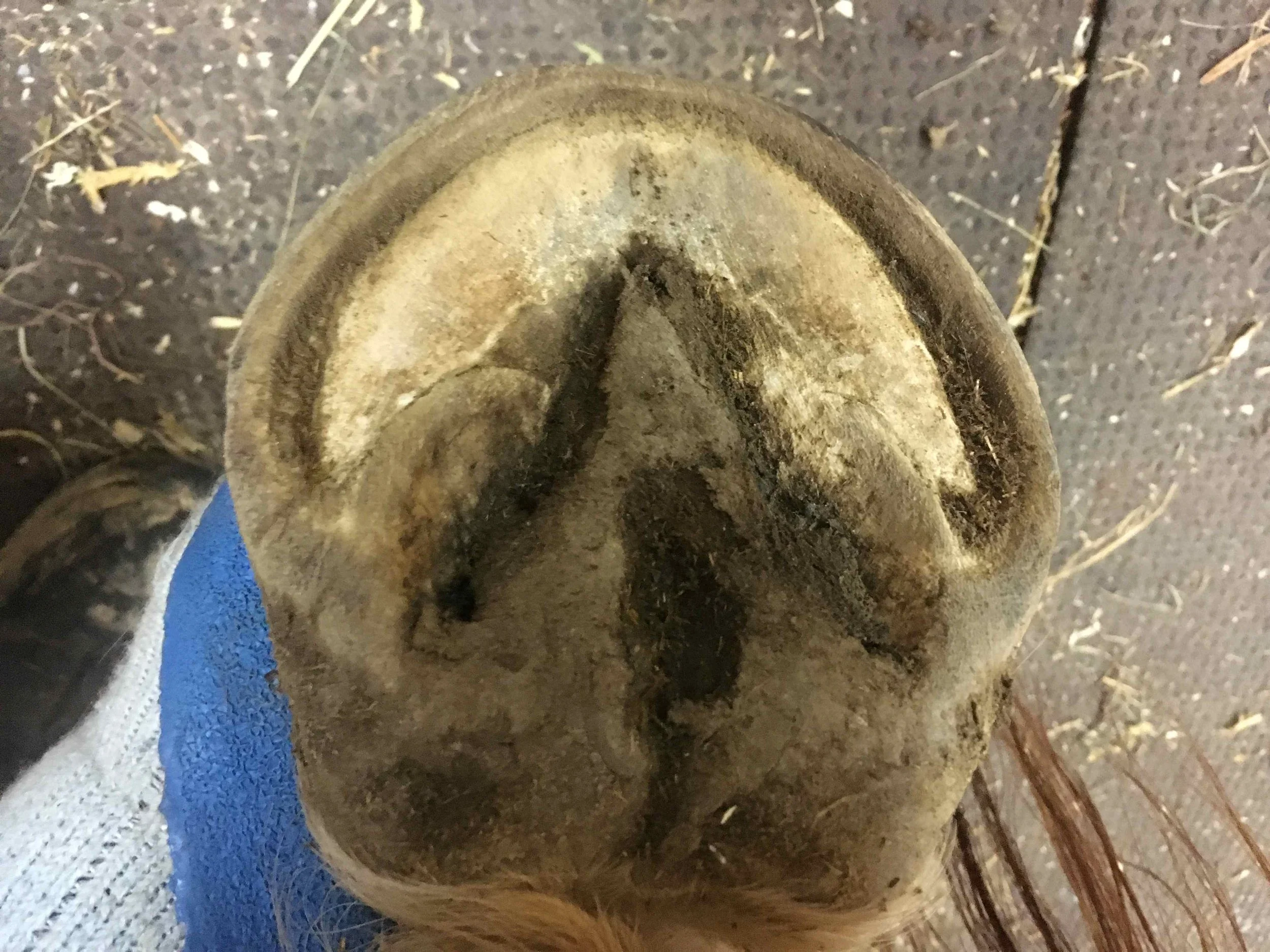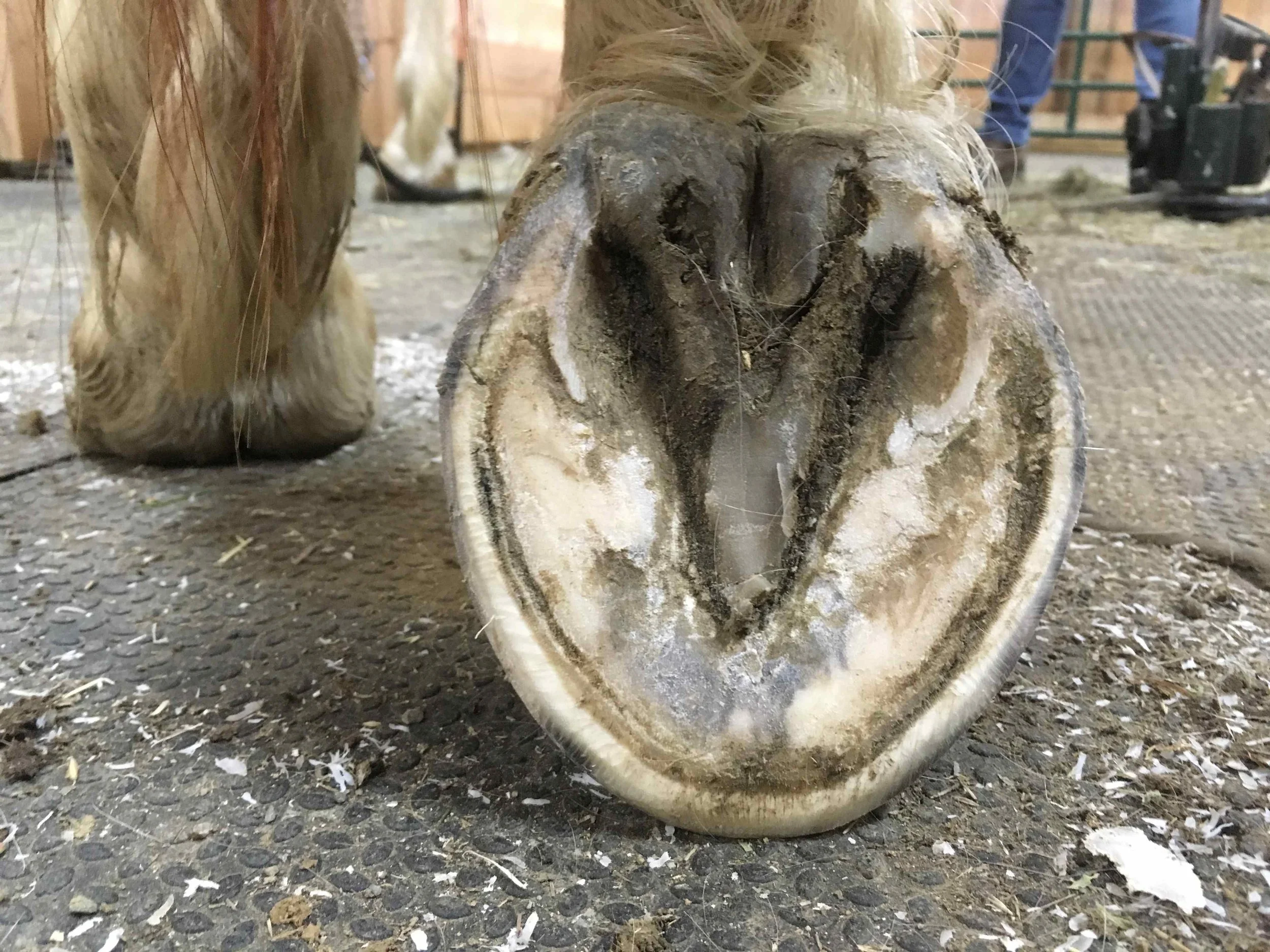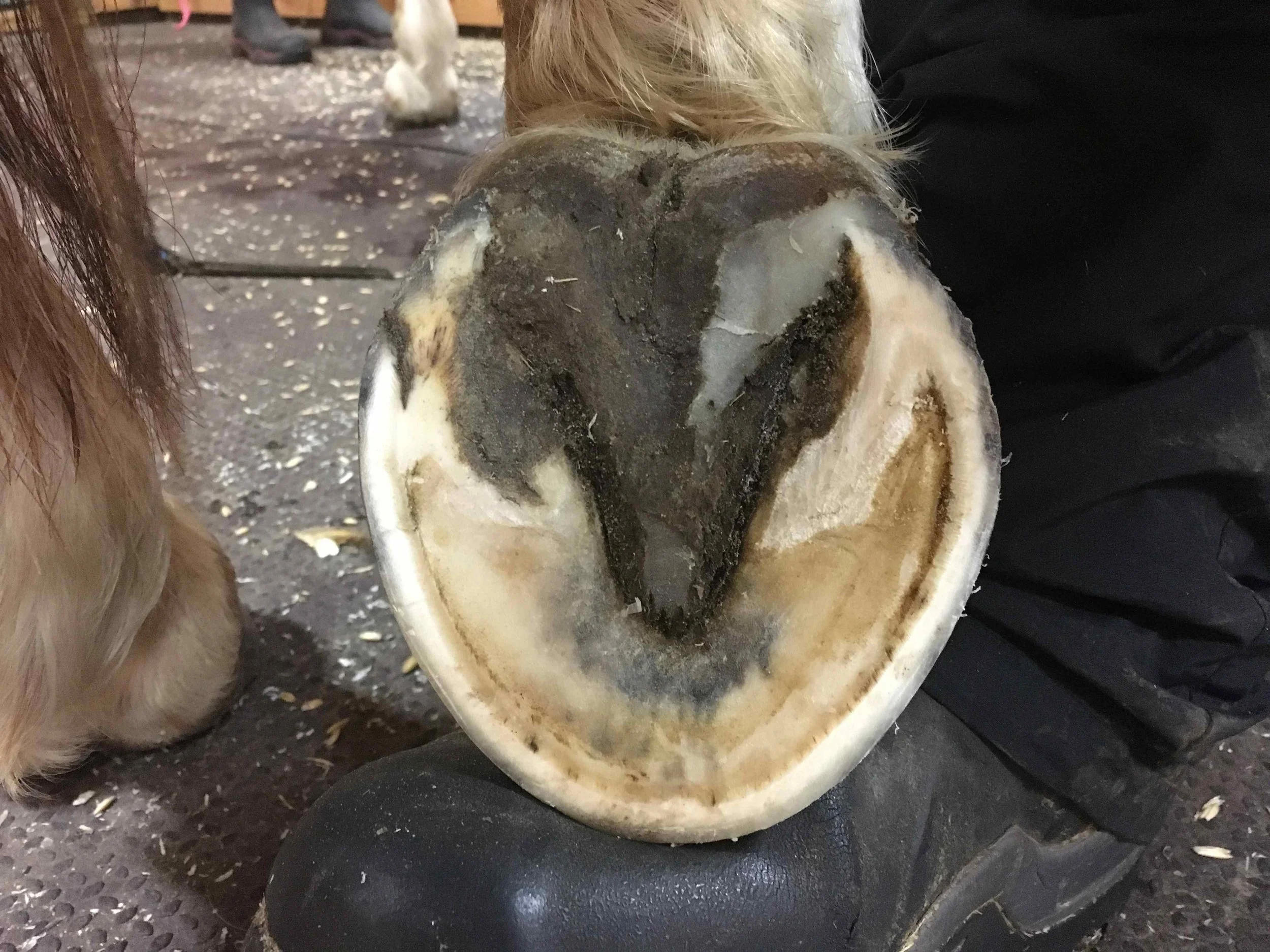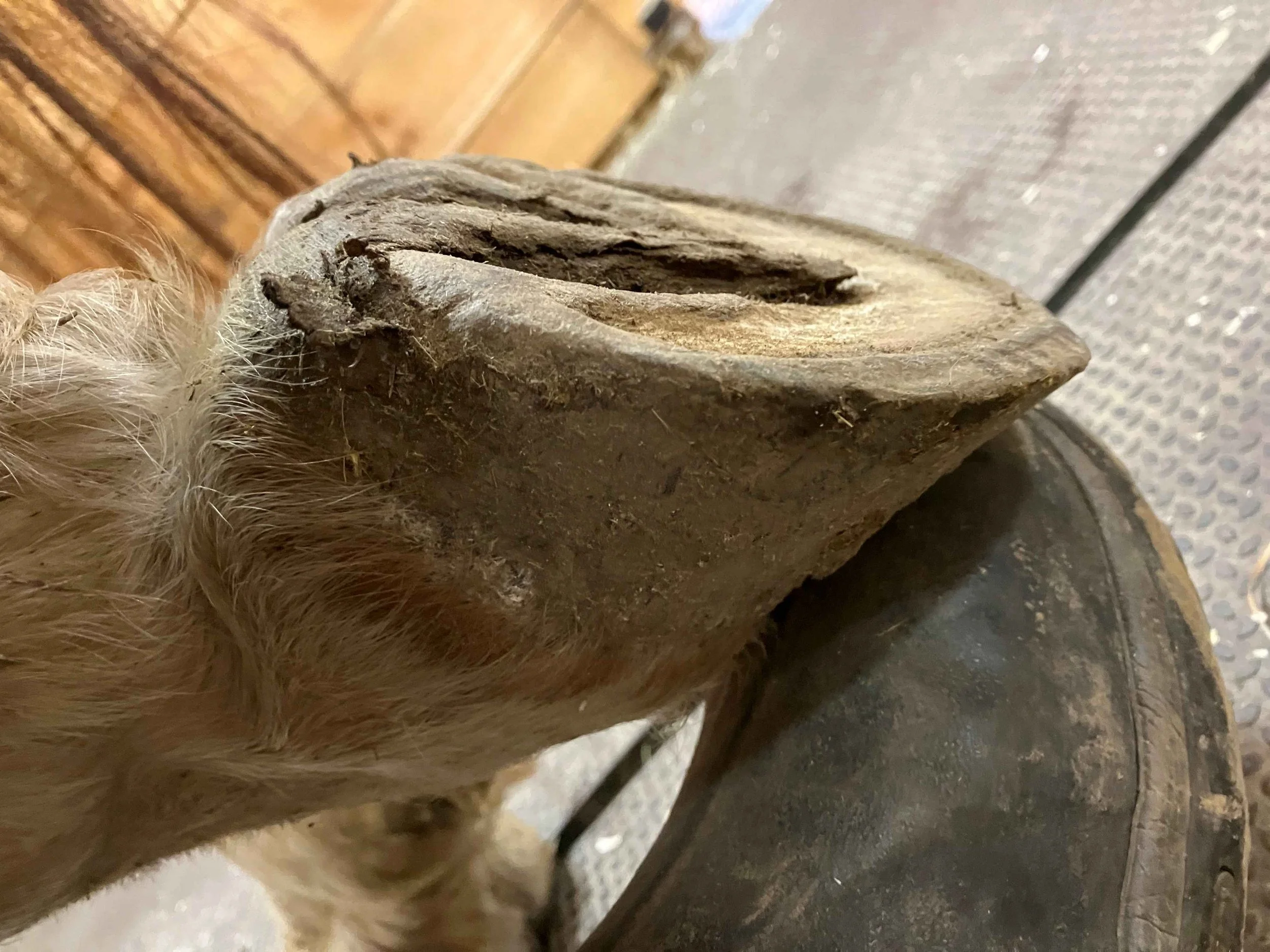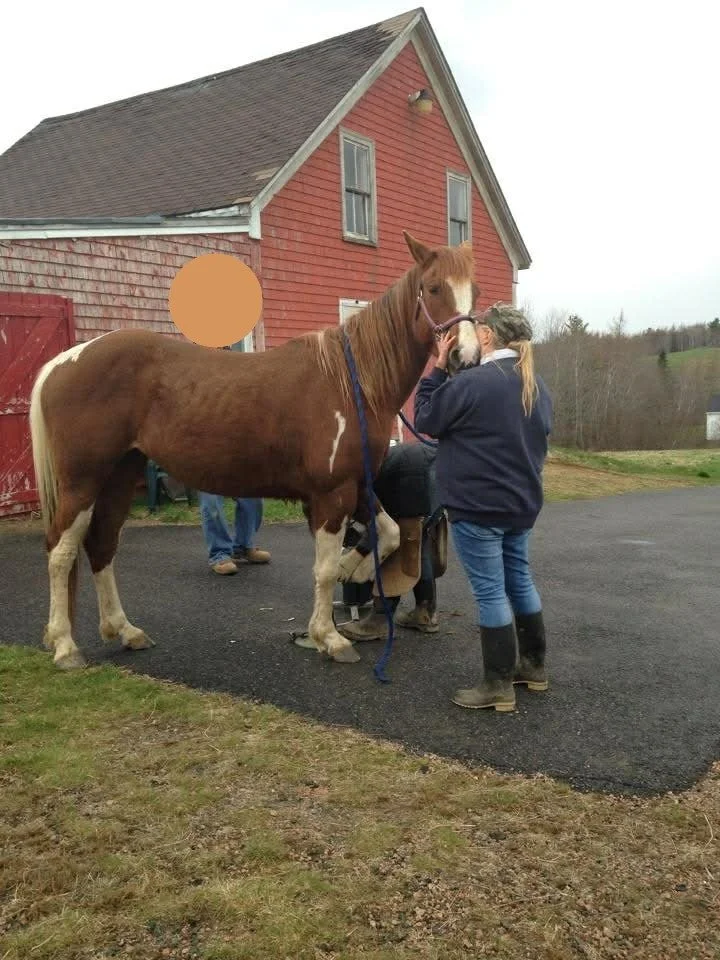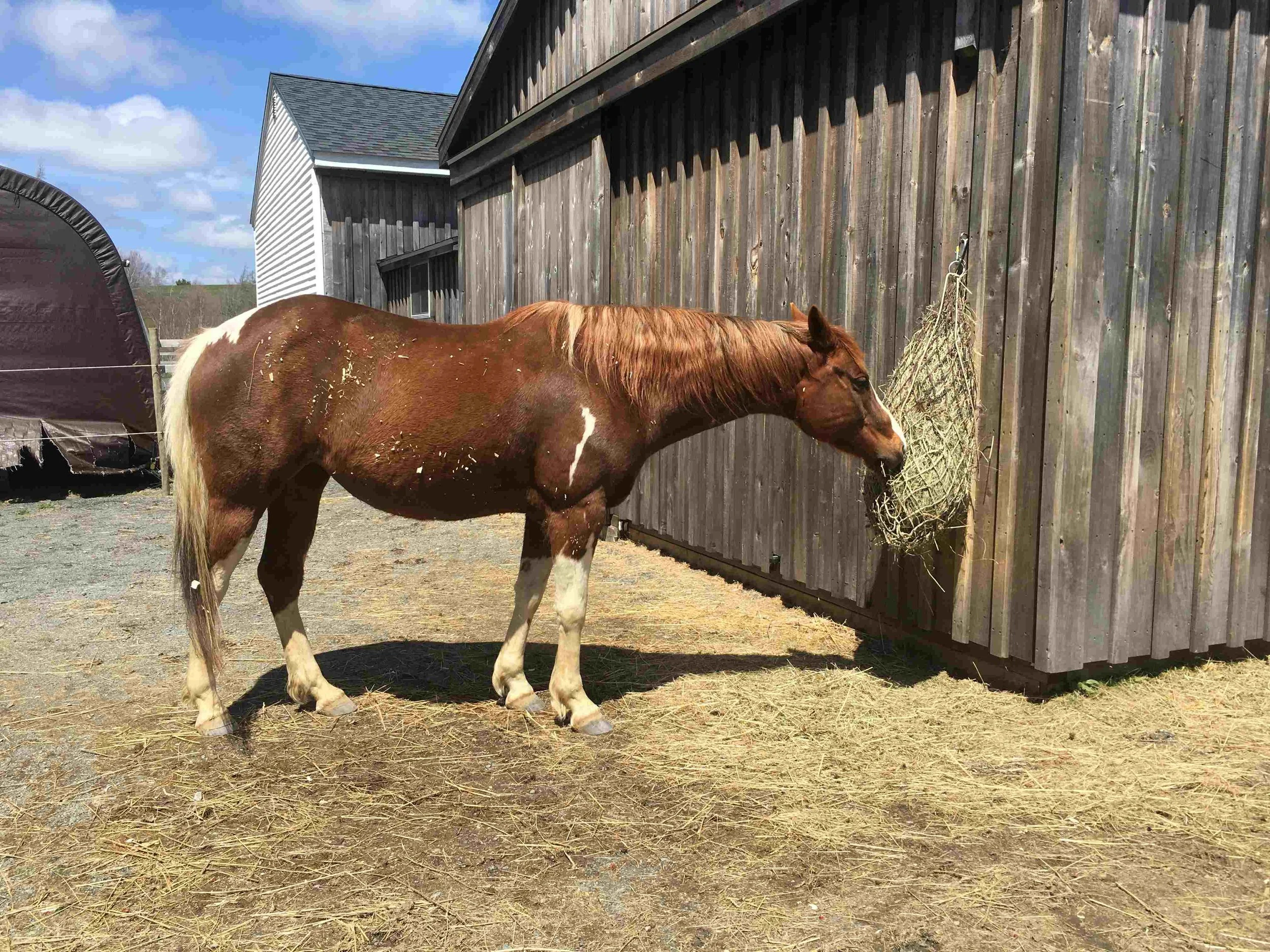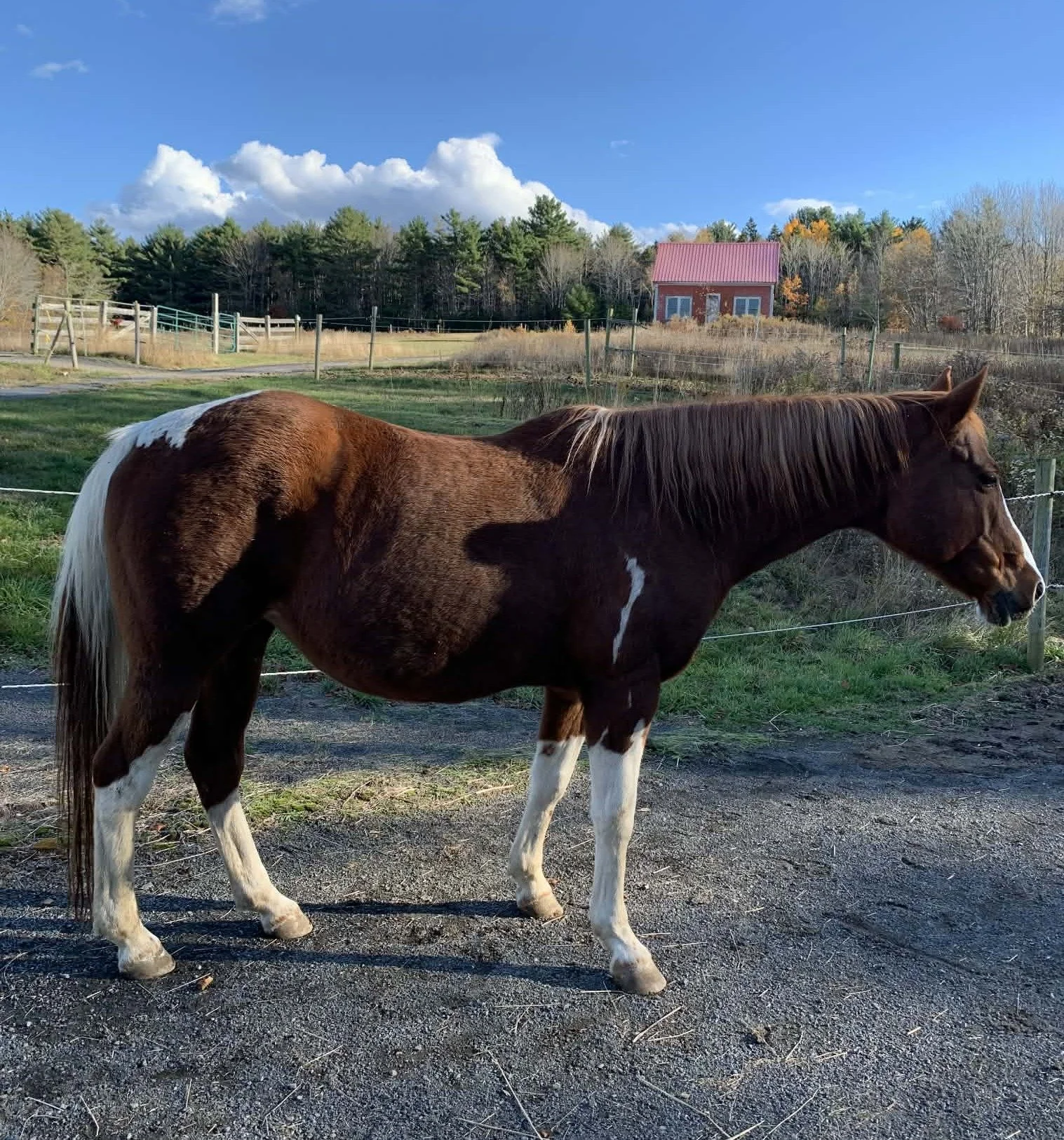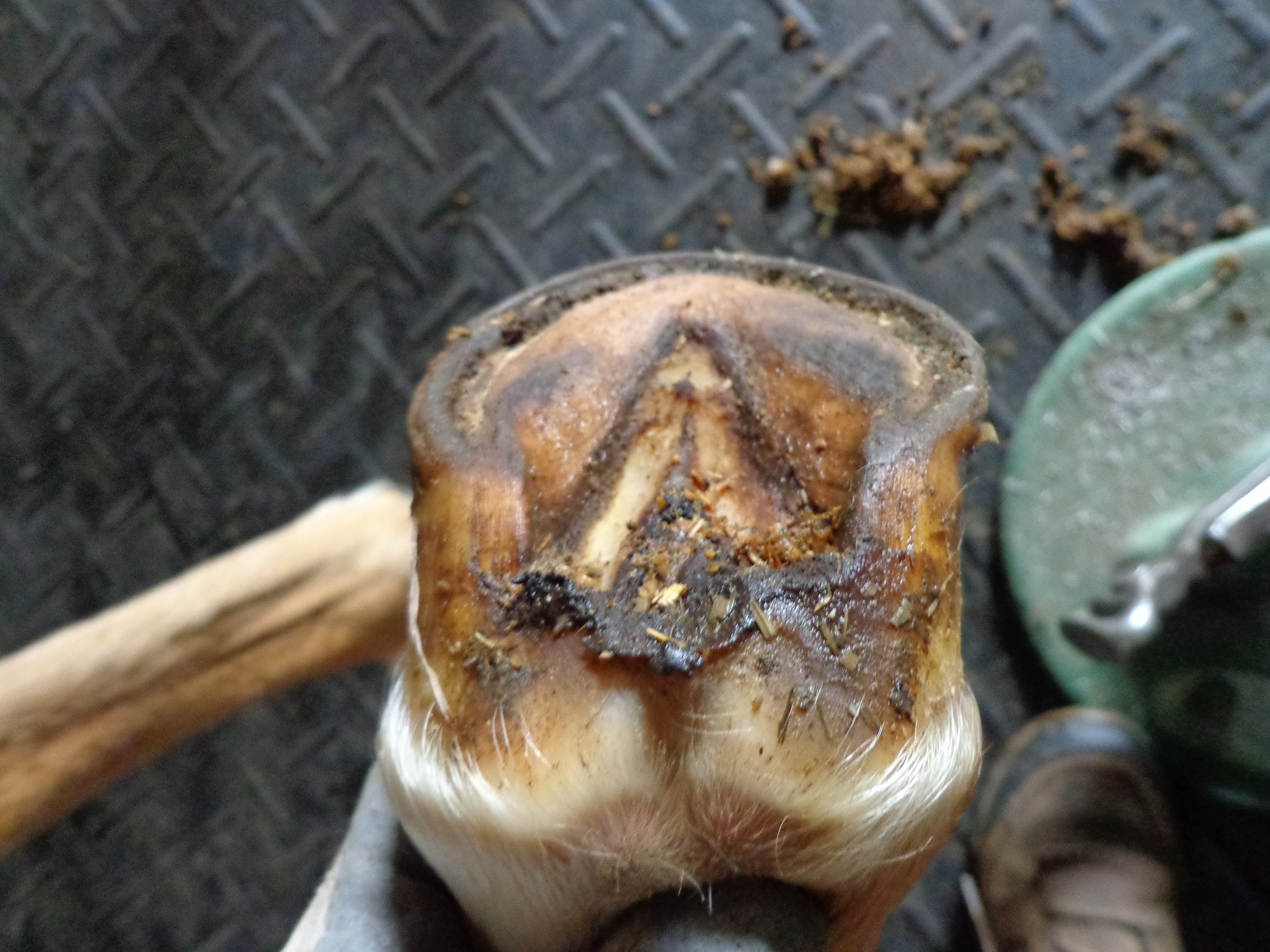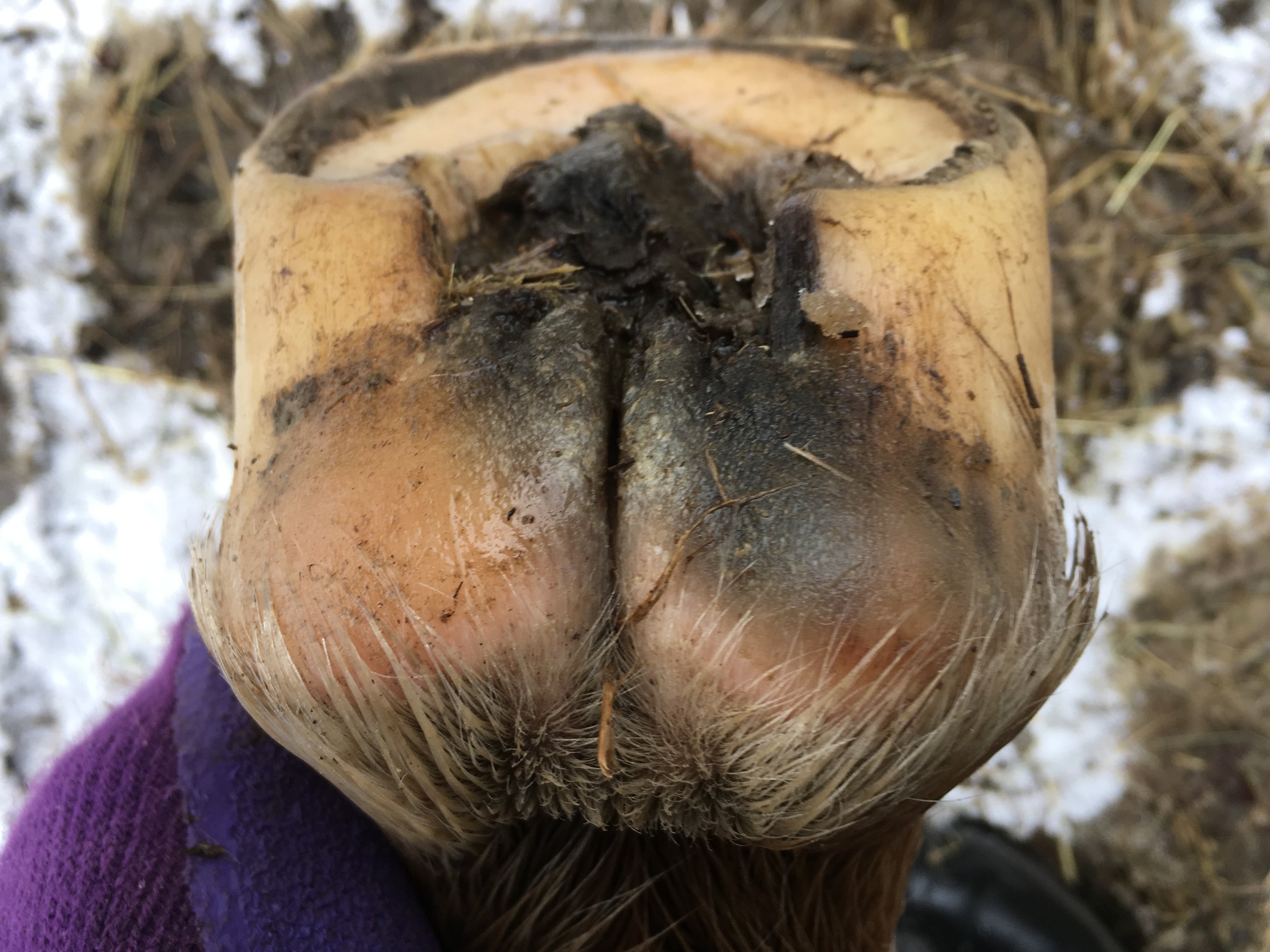Hoof, Body & Soul, Part III: Mission Impossible, unedited, by Gudrun Buchhofer. Blog 54, case # 54
CHAPTER 1
Atrophy, the fundamental cause for most all hoof pathology and upper body injuries
Diagnosed stifle injury
Case # 54
Storm
trimmed from December 2012 until present 2025
Storm, a Sorrel Tobiano, was born in 2008. My client bought her in December 2012. Storm had done some jumping and barrel racing, trail riding and clinics in western riding.
A pre-purchase examination said: “Both front feet are turned out, left is mild right is moderate. Slight hoof imbalance in both front feet, this is likely due to her hoof balance, medial heel slightly pushed up left front, worse on right front. Low heel, long toe and thin sole both hind feet. Base-line trot in a straight line reveals that she travels slightly higher with her right hip. At walk, trot and canter on the lunge line mare appears to be sound at this point in time, she did appear to catch her right stifle a couple times during downward transitions. Bilateral medial front limb splints noted. These are not painful and do not appear active. They do not appear to interfere with the suspensory ligament at this point in time. I would recommend using brush boots on both fronts due to her toed out conformation.” There also was a concern of an over bite.
Pre-trim first trim November 2012
I trim Storm since December 2012 and these are my first notes:
Petite hooves; imbalanced; hooves were most likely exposed to unnatural footing at and after birth (shavings, rubber mats, wooden stall floors, accumulation of straw or hay, pasture etc.); atrophy of the back of the foot; weak internal structures; soft tissue bruising; the hooves were clearly not under the bone column of the legs. Early on in her life Storm made an enforced decision how to brace in order to stand and move. She was then locked in that decision. Assuming she curled up to the right in her mother’s womb, Storm turned out the right front and right hind (leaning on the lateral side of the right hind). The flared tip of the false heel was ingrown into the soft tissue on the medial side in the right hind. She avoided to put weight on the medial heel. Every time I picked up Storm's hind feet there was a snatch from the tendon in both legs. Storm placed the left hind far under her belly and braced the situation with her left front.
Over the years hoof horn shifted around the coffin bone in all four hooves. All four emerged from further back positioning the feet more under the bone column. All four hooves increased significantly in hoof mass. We witnessed 4th dimensional healing changes. Between 2018 and 2020 there was a lot of visible increase of internal structures/digital cushions. That was also the time when the natural arch in the quarters appeared (following life sole plane).
Post-trim July 2018 — note how she is placing the left hind
Post-trim January 2021
Pre-trim August 2023 — Storm's left front requires the longest time for the healing.
Storm's left front requires the longest time for the healing.
Left front pre-trim of my first trim November 2012
Left front post-trim July 2022
There was a breakthrough with the right hind when true heel emerged on the medial side following an abscess in October 2020. The internal structures, bulbs and frog increased in mass. The bruising in the heel bulb as well as on the sole (in front of the tip of the frog) lessened from that time onward. The tip of the medial heel is no longer flared; it no longer pinches into the internal structures. The entire wear pattern changed for this foot after the abscess.
Right hind pre-trim March 2020 — the wear pattern prior to the abscess in October: she was leaning on the lateral side (wearing it down).
Right hind pre-trim October 2020
Right hind pre-trim November 2020
Right hind pre-trim January 2021
Right hind pre-trim November 2021
Right hind pre-trim April 2022
Right hind post-trim May 2018: frog still atrophied; the tip of the medial heel is flared and bruised; the sole is bruised in front of the tip of the frog; the white line is atrophied.
Right hind post-trim January 2021: still healing through the abscess at the medial heel; the central sulcus of the frog is filled; the tip of the medial heel is less bruised and less flared; the outer outside wall is less bruised: the sole in front of the tip of the frog is less bruised; the overlaid bar peeled off on the lateral side = revealing that the bar is more straight now; the white line connection is healthy.
I trust that the firm and abrasive environment helped immense with Storm’s healing besides the mimicking of natural wear patterns. This includes the application of a genuine mustang roll with the water line to always be the most distal part of the hoof capsule.
Left hind pre-trim December 2022 — six weeks after the last trim
Storm at the age of six in 2014 — dropped fetlocks left hind and right front — photo: Bonnie Swinimer
Storm at the age of ten in May 2018
Storm at the age of seventeen in October 2025 — the fetlocks are no longer dropped; the right hind foot is placed straight (no longer turning out) —photo: Bonnie Swinimer
Trimming Storm in February 2025 I found the medio/lateral balance of the right hind to be on the dime. All these years the hoof was always higher on the medial side because Storm used to lean on the lateral side of the hoof capsule.
Storm lives in the company of other horses outside 24/7 with access to a run-in shelter. The paddocks, arena and tracks are textured with crusher dust. The horses are on a fairly natural diet. They are offered first cut hay in slow feeding hay nets in several feeding spots, organic minerals and Himalayan or Redmond salt. There is no access to green grass pastures.
Storm is a happy horse and goes full tilt on the track.
photos: Gudrun Buchhofer
Stay tuned for the upcoming cases (under my care for up to 20 years) in this blog series as a replacement for the unpublished part III: Mission Impossible of my trilogy Hoof, Body & Soul.
What did all my client horses over the last 20+ years have in common? They needed to heal from atrophy of the back of the foot as well as other atrophied hoof structures.
Q: Why do we need to change the upbringing of our baby horses and donkeys? A: To prevent senseless suffering.
Gudrun Buchhofer

